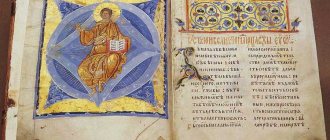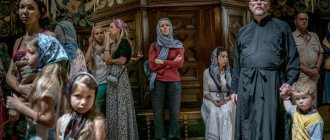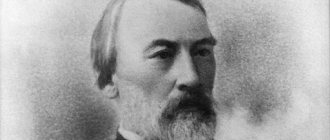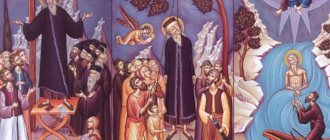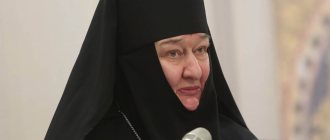History of the issue of the female priesthood
The question of the ecclesiastical service of Christian women in the Orthodox Church has been going on since the mid-20th century; various conferences either imposed a taboo on the priesthood of women, or brought this issue to a broad discussion of the priesthood.
This problem was first raised at the official church level in 1929 by Archbishop Feofan (Bistrov) after news appeared about the ordination of women to pastorate in Protestant churches. The priest called the virgins who encroach on the priesthood holy fools.
Female priesthood is prohibited in the Russian Orthodox Church
- In 1947, the World Council of Churches began a survey among Orthodox churches, including in Russia, on the issue of female priesthood.
- The year 1949 excites the minds of clergy through Professor Evangel Theodora, who advocates allowing virgins to be deaconesses; in 1954 he defends his doctoral dissertation on the ordination of deaconesses.
- In May 1972, Orthodox and Catholic priests take part in a conference organized by the Women's Ecumenical Coordination Group.
- The first breakthrough on this issue took place in 1976 during the First Women's Orthodox Conference, at which the problems of equal rights for women as clergy were raised.
- In 1977, students from St. Vladimir Seminary held a conference “Women in God’s Creation”; Elizabeth Ber-Sigel, Elena Gundyaeva and others were active participants in this movement.
- At the meeting of the Sixth General Assembly of the World Council of Churches, when considering the issue of the ordination of women, nun Martha (Kovalevich) was present.
- The 1997 Istanbul Conference initially suggested the possibility of discussing the issue of expanding the rights of women in ministry, but a final decision was never made.
- At an international conference in 2007, priests and government officials from many European countries spoke about the role of women in the modern world.
Member of the Seimas of Lithuania V. Orekhov spoke about the coming of the time for the restoration of women as deaconesses and the possibility of their ordination to the priesthood. The speaker justified his statement by the fact that the Lord gives Christian women the gifts of prophecy and healing, then why not entrust them with preaching the Word of God, confessing and giving communion to parishioners on an equal basis with men.
This statement was supported by several Western priests, including Metropolitan Anthony (Blum) of Sourozh.
Is the female priesthood a gift taken away?
Let them be silent?
The Holy Scripture says that in Christ there is “neither male nor female,” because in the Church all purely human differences disappear somewhere. They become not very important, not very relevant, as if not system-forming for our life in Christ. On the other hand, the same Apostle Paul says: let women be silent in the church. If they are so curious, let them ask their husbands about what they heard in the church meeting, and let them teach them. Because “the husband is the head of the wife,” and that says it all. As the eldest, he must teach the younger ones. This is a normal church tradition that dates back to Old Testament times and, probably, still legitimately remains relevant in the New Testament.
Now everyone knows that the place of women in the church is diminished. Although there are a lot of them, they are often poorly educated, and even if they are well educated, they are engaged in something else, often not in church service itself, not in solving difficult spiritual problems that are associated with mentoring and teaching - with what is generally usual belongs in the Church to Christ and to those who, as is sometimes thought, sit in the church assembly as if in the place of Christ.
Source: pxhere
What about the prophetesses?
Of course, in the ancient church no one ever sat in the place of Christ. This place was left unoccupied both during worship and at meals. But then something profoundly changed in the church, and already from the middle of the 2nd century a new era of church history began, associated with the so-called Eucharistic ecclesiology, where the high priest-bishop began to depict Christ at prayer. This is precisely where the male hierarchy is born, and some saints are already calling to look at the bishop almost as God. For example, we read this in the epistles of Ignatius the God-Bearer of the second half of the 2nd century.
The prophets and prophetesses stood in terms of the height of their ministry, essentially higher than the bishops, immediately after the apostles
However, there is reason to think that before this time women occupied a worthy place in the church. They could even prophesy - and prophets and prophetesses stood, in terms of the height of their ministry, essentially higher than bishops, right after the apostles - and there was no difference between a prophet and a prophetess. True, quite quickly, just by the middle of the 2nd century, the era of prophets and prophetesses practically came to an end, and over the next centuries the prophetic ministry in the church eked out a very miserable existence.
So, what did we initially have in church life? What could women do in the church that men could not do, and vice versa: what could men do that women could not do? This question has been tormenting the Christian conscience for a long time. There are many answers to this question, and they always contain the idea that we don’t fully know.
Equal to the Apostles, presbyterides, deaconesses
This is fair, and yet... Men were apostles, but women were also, if not apostles, then equal to the apostles. We remember Nina Gruzinskaya, Equal-to-the-Apostles Helen, Olga, and Mary Magdalene. This means that women could preach, as well as prophesy, on an equal basis with men.
Later it turned out that women could perform liturgical sacraments, up to the sacrament of baptism and - scary to say - the sacrament of communion, and this did not bother anyone. They could lead Christian prayer meetings and meals of love - agapes, which were also sometimes called sacraments. These women, who could be senior members of the church congregation, were called presbyterides. Their ministry is another secret of our church tradition and history. And only in the 4th century, for reasons that are not very clear, in some province of the Roman Empire the service of presbyterides was abolished, and this somehow turned out to be accepted by everyone.
Women's Eucharistic night meeting with presbyteride presiding. Fresco in the Roman catacombs of St. Priscilla.
We know that from the 1st to the 10th century there were deaconesses in the church. We find mentions of them already in the Holy Scriptures of the New Testament. This means that both brothers and sisters could equally perform the service of diakonia, the service of mercy, the “sacrament of the brother.” And it is no coincidence that the subsequent ordination of deaconesses to service (ordination) took place in the altar. They were dressed in sacred clothes - a surplice and an orarion - and received communion on this day at the altar, immediately after the deacons. They could also help with baptism (especially sisters), and perhaps, if necessary, baptize them themselves.
Tradition or inertia?
So, in fact, the sisters could do everything, and they were not at all diminished in front of the brothers in the church. The only question is whether they could celebrate the Eucharist itself, that is, the sacrament of thanksgiving. The sacrament of communion - they could, but the sacrament of thanksgiving? This is a controversial issue. The oldest church books say that prophets should be given “to give thanks as much as they wish.” It is not said, however, “to the prophetesses,” it is said to “the prophets.” But the fundamental difference between a prophet and a prophetess is not mentioned anywhere. Thus, there is no direct evidence of women performing the sacrament of the Eucharist and the sacrament of thanksgiving. True, there are no prohibitions on this matter.
Should this be considered an accident? Maybe this silence is cultural, spiritual inertia. For the Old Testament, it was difficult, even impossible, to think about such a ministry for women, but in the New Testament, just until about the middle of the 2nd century, there was a very strong Jewish influence. And when the influence of the Hellenic principle in the church increased due to the entry into it of many people from pagan peoples, who in their tradition had priestesses, that is, priestesses, and prophetesses, then the picture already changed within the church. Due to the emergence of the church hierarchy in the mid-2nd century, it became increasingly difficult to imagine that any woman could celebrate the Eucharist. True, during the time of Tertullian, at the end of the 2nd - beginning of the 3rd century, the Montanists somehow tried to restore the former women's ministries (it is no coincidence that the founders of this movement were the Phrygian prophetesses), but at that time this already caused resistance in the Catholic Church, which was logical in the conditions of a victorious eucharistic ecclesiology.
In some Orthodox churches the ranks of deaconesses and their ordination have been revived again
So, we have a very interesting picture, which suggests that the church tradition, although it has sometimes developed contradictorily, contains enormous potential regarding the ministries of women, which can be revived. Already now, as you know, in some Orthodox churches the ranks of deaconesses and their ordination and consecration have been revived. In particular, in the Patriarchate of Alexandria. This is increasingly being talked about in various circles of other Orthodox churches.
Not only mother father
There is a demand in the church for the revival of the priesthood of women: this enormous potential of strength, energy, mind and spirit must be used better than it has been for many recent centuries. It is already clear to everyone that women can be not only mothers of priests, not only do menial work - washing floors and candlesticks in the temple - or, at best, be altar girls if they are nuns or widows.
Florence Lee Tim Oy (1907–1992). In 1941, after receiving her theological training, she became a deaconess and served the Chinese refugee community in Macau. Source: womensordinationcampaign.org
By the way, in the ancient church “widows” was another special rank of service for women, usually elderly and lonely. Their service, most likely, was close to deaconic, but now it is not very clear how they, in fact, differed from deaconesses. It is only clear that these ministries were different and did not mix. Maybe these widows supported single women, old people and raised children.
And although no one has brought forward serious theological arguments against the female priesthood, and perhaps they do not exist, tradition is a stubborn thing
On the path to reviving women's church ministries there are now both achievements and difficulties. In the 20th century, a whole discussion arose about the revival of the female priesthood. There was a desire to include the great potential of Christian women, sisters, into the active role of church life. Although the idea itself was perhaps not bad, this priesthood was misunderstood, misinterpreted and implemented, a little mechanically - on the model of the ministries of the brothers: they even began to be ordained like bishops, presbyters and deacons are ordained. The tradition of the ancient church was not fully taken into account, and this caused protest - primarily in the Orthodox and Roman Catholic churches, which did not recognize this practice as traditional and justified. And although no one has brought forward serious theological arguments against the female priesthood, and perhaps they do not exist, tradition is a stubborn thing. They referred to it, and this had its own truth and strength.
I remember that in Rus' some princesses were canonized. Although this ministry - to be at the head of a principality or kingdom - the history of the church is also difficult for women, but still we remember these cases, including in the history of Russia. True, as for queens or empresses, in our country they were quite far from canonization in terms of the quality of their personal lives, although they could be patrons of the church and resolve many church issues.
So we have touched on all the most fundamental aspects of church ministry: the kingdom, the priesthood, and prophecy. The kingdom is available to the sisters, prophecy is also available, and the priesthood is, apparently, only partially. It is unknown what will happen next, but for now it is impossible to imagine that bishops or presbyterides will appear in the Orthodox Church in the image of those priests-bishops-presbyters whom we have today. True, the modern image of the ministry of presbyters and bishops is very different from the image of their ministry in the ancient church, as well as, in fact, deacons and deaconesses. Colossal shifts have occurred, as Protopresbyter Nikolai Afanasyev, Archpriest Sergius Bulgakov and others have already written about.
In 1992, the first female bishop, Maria Jepsen, was ordained in the Evangelical Church of Germany. Source: episcopa.blogspot.com
Good mutation
If some sister-prophetess were to enter the church now as someone with authority, what could we say to this? We would probably see that she can preach in a church meeting, as all those who have the gift of speech and testimony do, as bishops, elders, and sometimes deacons and lay men often do. But women can do this too; such cases are known. A female prophetess—could she now lead a church congregation? In some special, difficult living conditions - and in our time this is easy to imagine - she probably could. She could announce, baptize, and become the head of an Orthodox community or an entire church brotherhood.
From century to century the church has become accustomed to seeing a brother in this place - a bishop or a senior presbyter
All that remains is to admit: virtually all male, fraternal ministries in the church can—more precisely, could—be performed by a woman if she has the appropriate spiritual abilities and gifts. Only if we talk about the Eucharist, about thanking God for the sacrifice of Christ, for giving us an inheritance of the Kingdom of Heaven, if we talk about prayer over the Eucharistic sacrifice, over the Eucharistic bread and wine, then, probably, some difficulties would arise, objective, justified ancient tradition - the fact that from century to century the church has become accustomed to seeing a brother in this place - a bishop or a senior presbyter.
But we can imagine something else: that we again abandon the idea of the Eucharist as a sacrifice and, therefore, the priesthood as a priesthood and restore the New Testament royal priesthood of all the people of God, when the only High Priest in the Church is Christ. Then the sisters, as members of the People of God, can praise and glorify God, “proclaiming the praises of Him who called us out of darkness into His marvelous light.” Can they thank God at the same time? They can. Can they lead agape meetings? They can. Thus, if we do not focus church attention on the teaching about the hierarchical priesthood and the Eucharist as a sacrifice, then the question arises: where is the obstacle that would prevent a woman from offering the Eucharistic prayer to the Church and thanking God for Christ - approximately as is reflected in the Eucharistic and agapic prayer recorded in the ancient monument “Teaching of the Twelve Apostles”?
One of the greatest Orthodox theologians of the 20th century, Professor Protopresbyter Vitaly Borovoy once told me that there really are no theological arguments against the female priesthood, understood precisely as the gift of heading the Eucharistic assembly, in the Orthodox Church - there are only tradition and habit. In our time, when the inertia of the Jewish Old Testament consciousness, for which it was impossible to imagine female priests in the temple, has long gone in the church, and when the idea of hierarchy associated with Eucharistic ecclesiology and the doctrine of the Eucharist as a sacrifice is gone, we can cautiously assume that The question of the fullness of women's ministry in the church is becoming more pressing than ever before.
And indeed, in case of need, when, for example, there is no way to find a bishop or an elder presbyter to ordain a new primate of the Eucharistic assembly, or when there is no worthy male candidate to appoint a senior to the ministry in the Christian community, then it may happen - I almost said “in in our conditions, coronavirus” is a mutation, and something that has not happened in history, or almost never happened, may appear. But this cannot be done arbitrarily - just because someone wanted to experiment, or only on the basis of historical and logical conclusions, even of a theological order. Mutations can be bad, harmful, pathological; they can mean illness, sometimes even a fatal illness, as in the case of the coronavirus, but they can also be positive, useful for the church and the church people.
I in no way want to prejudge any conclusions, but I want to say that our tradition is mobile and alive and that the real genuine potential of Christian sisters - spiritual, emotional, mental, material, and physical - is very great and, of course, everything has not yet been exhausted. It still has its secrets and its undisclosed possibilities.
Material prepared by Oleg Glagolev
Why can't a woman be a priest?
Elisabeth Ber-Sigel, for whom there are no theological obstacles, relies on the assertion that the image of God lives in every person, regardless of gender. (Gal.3:28). Jesus was a man first and foremost.
- The Holy Spirit did not freeze in its movement in the last century, in which church traditions about the ordination of only men were accepted, but there was no taboo on the ordination of virgins.
- Virgins Equal to the Apostles, real deaconesses have been known since ancient times; Saints Helena, Magdalene, and Princess Olga influenced the course of the Christian faith. If women can be trusted to be deaconesses, why is the priesthood banned?
Holy Equal-to-the-Apostles Princess Olga - The image of the Church in the catacombs was depicted as the Virgin Mary, under whose cover both the royal priesthood and all people, men and women, are united. Saint John Chrysostom wrote that the priest is the hands and tongue offered to serve Christ. How are Christian women’s hands different from men’s hands?
- The issue of female uncleanness on certain days was removed by the Apostolic Council on the basis of Acts, chapter 15.
Paul's words about the husband as the head of his wife (1 Cor. 11:3) can be seen as about the hierarchy in the family. In another translation, the head means a source, a spring of living water that flows to all people, regardless of nationality, gender and age.
Read about women in Orthodoxy:
- Why should Orthodox women wear a headscarf?
- Can women wear trousers to church?
- Is it possible for a woman to go to temple during her period?
What does the Bible and saints say about man?
In the book of Genesis we read that Adam was created in the image of God from dust, and Eve was literally created by God from His own likeness. The Word is also the image of God. The value and significance of the human person does not depend on skin color and gender; Christ Himself abolished the division of human nature based on gender. (Gal 3:28).
There is a Divine part and a natural part in man. Saint Gregory of Nyssa draws our attention to the fact that the Lord creates man in His image, but unlike the Divine essence, man can be either a man or a woman.
There is not a single fact in the Bible confirming the possibility of a female priesthood
This issue is discussed in the letters of St. Ephraim the Syrian and St. Ambrose of Milan, which emphasize the uniqueness of Eve, created from God's perfect creation. Created from a rib, Eve has the same bodily nature as Adam, for they have the same Source.
The message of Blessed Augustine says that before her creation, Eve was already the mistress of God’s creations. However, the letters of the saints emphasize the difference between the sexes, which appears in many ways;
- Eve was created from the rib of the already created Adam, this is his primacy;
- Adam gave names to creatures, and he chose a name for Eve;
- Eve is called a helper and is called upon to give birth.
St. John Chrysostom and Theodoret of Cyrus believe that the primacy of creation and the covenant to be the cover of a wife gives men supreme power, and the root cause lies in the Fall through the fault of Eve, but the Apostle Paul in the First Epistle to the Corinthians makes an amendment that these two creations cannot exist one without the other.
Nowhere in the Bible, in both the New and Old Testaments, is there a single woman priest. Women's ministry was to bear the gifts of prophecy, as Miriam did, to be a judge, at that time this was equivalent to government, like Deborah, the judge of Israel.
Gradually, women's ministry faded away, leaving old women, widows and virgins who dedicated their lives to the Savior. Ancient deaconesses provided communication between the male and female parts of the church, helping in the baptism of women, caring for sick and infirm Christians, and putting things in order when cleaning the temple.
There was no ban on the ministry of deaconesses; this movement itself disappeared due to irrelevance and uselessness.
The ministry of deaconesses is being revived in the Orthodox Church (Finland)
According to the saints, the origins of the female priesthood are not the Bible, but feminist ideas that are actively flourishing in the West. Feminists strive to prove their equality with men in the ability to perform male duties, arguing that they have outgrown the functions of a wife and mother, and not everyone is given the role of caretaker of the family.
Elisabeth Ber-Sigel dreams of a future with the evangelical image of Christians who have achieved the opportunity to freely realize their potential; the basis of her teaching is Christian feminism, which requires a revision of some concepts of the Orthodox Church.
Saint Epiphanes of Cyprus expressed a sharp denunciation of the Kolliridian heresy; he emphasizes the fact that deaconesses were never ordained to the rank of presbyters or priests.
Patristic traditions do not discuss this issue, but they do not remove it from the agenda. The actively developing priesthood of women in Protestantism may have an impact on Orthodox churches in the future.
Read about holy women in Orthodoxy:
- Life of Saint Anna Kashinskaya
- Life of the Holy Great Martyr Catherine
- Life of the Holy Great Martyr Barbara
Orthodox Life
Today it is already obvious to many that the current world community is moving more and more away from traditional Christian values.
And it doesn’t just move away - it actively destroys them, offering in return some kind of surrogate constructed by unhealthy minds, extracted from places very close to the underworld. New living norms and standards under the slogans of tolerance and universal gender equality are being intensively promoted and imposed in all spheres of modern man’s activity. But the saddest thing is that they penetrate the religious consciousness of people who consider themselves Christians, and gradually begin to take root in individual Christian denominations. Increasingly, attempts have been made to reform and revise certain traditions and even aspects of Christian teaching in order to please the corrupting influence of this age. Various organizations and individual governments, advocating for absolute, comprehensive equal rights, and actually defending the interests of only certain groups of people, put pressure on the religious community and the Church on issues that are the area of competence exclusively of religion, but not of civil law.
One of these topics imposed on the Christian Church from the outside was the question of the female priesthood, which has been very actively being pushed into the minds of both believers and non-believers since the mid-60s of the last century, especially after a number of Evangelical Lutheran Churches in Scandinavia , and then the Anglican Church of Great Britain, under pressure from secular authorities, signed documents and began to carry out the ordination (ordination) of women. But it is not surprising that in countries where the Churches had (and in some still continue to have) state status and were governed either by parliaments or relevant ministries, and which only recently gained independence in leadership, such decisions are very quickly implemented . For example, in Sweden, where the head of the Church was appointed by the government until 1997, the issue of ordaining women to the clergy was decided by parliament, which adopted the corresponding law back in 1958. The same thing happened in England. After the passage of legislation by the British Parliament allowing the elevation of women to the rank of bishop, there followed an approving conclusion of the General Synod of the Anglican Church. At the same time, it is impossible not to notice the trend that simply catches the eye: as soon as the next Protestant denomination in Europe or America legitimizes and introduces female ordination into practice, this is very soon followed by the acceptance of homosexual “marriages,” their blessing and even “wedding.” This chronology is not difficult to trace. And this is not an accident. Everything is going towards accustoming the population (including Christian believers) to the idea that a woman priest, sodomy cohabitation, and the so-called diversity of genders are the absolute norm and that there is nothing special about being a lesbian or transgender may be part of the clergy. From 2009 to 2021, the diocese of Stockholm was ruled by the gay “bishop” Eva Brunne, who, by the way, was also remembered for proposing to remove the crosses from the church in the port so that they would not confuse followers of other religions. A religious community headed by such a “bishop” cannot be called a Church in the true sense of the word, especially considering that in Sweden, until a certain point, one could become a member of the Church either by birth or by application without the rite of baptism. Only since 1996 has baptism become a mandatory condition for membership, and then with many “democratic” reservations. The book “State and Church in the 20th Century” cites an interesting fact that speaks for itself: in the 1990s, among the flock of the Swedish Church, about 500 thousand of its members were not baptized, and some of them were even agnostics and atheists!
In many countries of Western Europe, Protestant Churches have long been just associations that perform either the functions of a state-municipal body, which remains in charge of overseeing cemeteries, or play the role of nominal national symbols. Of course, it is worth noting that not all Christians of Western denominations are ready to put up with this state of affairs. There are still healthy forces opposing decisions that contradict gospel norms. In November 2014, after the head of the Evangelical Lutheran Church of Finland, 50% of whose clergy, by the way, are female pastors, publicly approved the law on gender-neutral marriage adopted by the country's parliament, more than three days left its ranks in protest. 13 thousand people. And this is not an isolated case. Some representatives of the hierarchy of Protestant denominations also express their indignation - they are well aware of how such “innovations” can end for Christianity. In 2021, a fairly well-known personality in Great Britain, an honorary royal chaplain, Bishop Gavin Ashenden, due to disagreement with the “progressive” changes that are taking place in the Anglican Church and corrupting the flock, renounced his rank, and soon left the Church altogether. However, the voices of such dissenters are not enough to counter the efforts of those who are trying to turn people into a manageable herd. Western Protestantism actually surrendered without a fight and collapsed under the pressure of secular society, both on the issue of the female priesthood and gender politics. However, this was to be expected. Because the “doctrine of universal priesthood”, which exists in Protestantism, denies the attitude towards the priesthood as a Sacrament and rejects any “sacred” difference between clergy and laity. The founder of the Reformation, Martin Luther, taught that any baptized believer can consider himself already ordained as a priest. Therefore, from this point of view, gender does not play any role in the priesthood. After all, a priest in Protestantism is an ordinary pastor who plays the role of a preacher or minister, whose main task is not to communicate grace to a person, but to preach and teach faith. That is why Protestants show such loyalty to women's ordination, because they believe that an educated woman who has the gift of teaching and possesses the qualities of a good administrator and leader can easily cope with such a task. In addition, Protestantism lacks an understanding of the Liturgy as a Eucharistic sacrifice offered by a priest and faith in the transmutation of the Holy Gifts into the Body and Blood of Christ.
Currently, the views of advocates of the female priesthood are turned towards the Orthodox and Catholic Churches, which they accuse of excessive conservatism in this matter and of unwillingness to revise the centuries-old regulation prohibiting the ordination of females, regarding this, of course, as another discrimination and violation of rights . All kinds of feminist and non-traditional organizations and those who support them, as well as some very “advanced” theological representatives, make statements demanding that the historical Churches decide on this dilemma. And we are no longer talking about restoring only the institution of deaconesses, which existed in the Eastern and Western Churches until a certain moment, while this was necessary, but discussions are being held about the full priesthood, allowing women to carry out liturgical service and receive confession. However, the Orthodox Church made up its mind on this issue more than two thousand years ago. Supporters of the female priesthood, pointing out that the challenges of the present time require a rethinking of old traditions, are forcing the Church to make new decisions. But in this case we are not talking about ordinary human tradition, which can be changed or abandoned to please anyone, but about the Divine institution adopted by the Christian Church from Her Founder Himself. What was said by Christ in the Upper Room of Zion at the time of the Last Supper, surrounded by disciples (not female disciples), cannot be undone by any human decisions. And if the Word of God does not say anywhere that a woman cannot be a priest, this does not mean at all that the opposite can be allowed. In such fundamental issues one cannot be guided by the principle: what is not prohibited is permitted. With such a dubious approach, it is possible to distort the entire Holy Scripture and Tradition of the Church and bring many things to the point of absurdity.
The Orthodox Church, unlike Protestantism, is characterized by a special understanding of the priesthood, which is a Sacrament established by the Lord Himself. He Himself chose the apostles from among His followers and disciples, giving them the authority to teach and perform sacred rites, and sent them the Holy Spirit after His Ascension. An Orthodox priest performs the Church Sacraments by the power of Christ, and Christ, who has taken into Himself the fullness of human nature, without division into male and female, nevertheless remains a Husband. Today women carry out a lot of different ministries in the Church, coping well with the functions assigned to them, without any ordination.
In its origin, the idea of a female priesthood is not evangelical, nor is it found in the Tradition of the Church. But it is found in the ancient Gnostic heresies, which the Christian Church fought at the beginning of its emergence. Saints Irenaeus of Lyons, Epiphanius of Cyprus, John of Damascus, and also Augustine the Blessed mention in their works the 2nd century sect of the Marcoseans, or Marcosians, whose founder, a certain Mark, is called a sorcerer and forerunner of the Antichrist. The “Eucharist” in this sect was celebrated by women in the presence of its heresiarch. Saint Epiphanius also writes about the Collyridian sect, at whose “divine services” women made sacrifices, broke bread and “communed” in the name of the Virgin Mary. In his work “Against the Collyridians” he says: “From the ages a woman has never performed a sacred act; even Eve herself, although she committed a crime, did not dare to commit such an unholy deed; and neither did any of her daughters, while Abel soon performed sacred acts to God, and Cain...” A little further he o. Tracing the history of the succession of ordinations from the apostles, St. Epiphanius draws attention to the fact that nowhere is it said or mentioned that at least one woman was appointed among the bishops or presbyters. He also explains the functions of the rank of deaconesses in the Church, who never performed any sacred rites, but carried out assignments related to protecting the honor of the female sex, either at baptism or when leaving during illness. In ancient times, there were other heretical communities in which women not only served as priests, but also led them. Among these were, for example, the Pepusians. It is worth paying attention to the fact that all the ancient heresies in which the female priesthood was practiced justified it with the same arguments as those used by its current supporters. Here is the point about the universal “royal priesthood” (1 Pet. 2:9), and quotes from the Epistle of the Apostle Paul that in Christ there is neither “male nor female” (Gal. 3:28), and mentioned in Bible passages about women's prophetic ministries. Current supporters of the ordination of persons of the weaker sex always draw attention to the fact that in patristic literature this issue has been practically unexplored and has been little discussed. But this argument also testifies rather against, rather than for, the female priesthood, because the Church initially adopted the order of things that it preserves to this day. And, as we see, it never occurred to anyone except the heretics to change this.
At the present time, the “noise” around the issue of women’s ordinations is actively being made by feminists. For them, gender recognition is not a natural biological given, but a right of personal choice. That is why they strive in every possible way for complete social equalization of men and women, not taking into account the fact that the Church is not an ordinary social institution, but a Divine-human organism, and in the ontological dimension, the Body of Christ. And the priesthood is not a position at all, but a sacrificial sacred service. A revision of this issue may be tantamount to a distortion of the foundations of the Christian faith and a rejection of the evidence that we have in Holy Scripture and Tradition, and may also completely erase the entire historical experience of the Church and its institutions in this aspect.
The topic of the female priesthood is another “Overton window”, and no one knows what might penetrate it next time.
Valentina Novikova (Chernysheva)



